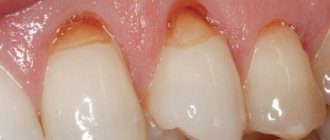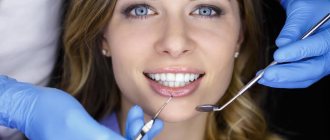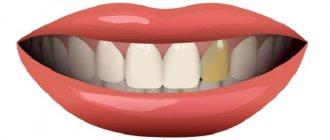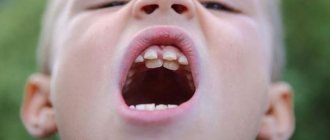In 6-10 year old children, baby teeth often fall out - a harbinger of the appearance of permanent teeth in their place. This fact should not cause any particular concern. However, there are cases when real teeth begin to loosen on their own. This is a signal that you need to consult a doctor without wasting time before the child’s health condition becomes dangerous. Loosening of baby teeth is a sure sign of a malfunction in the immune system.
Loosening of permanent teeth is a sign of both emerging diseases in the oral cavity and sudden problems with internal organs. The most common manifestations are:
- Periodontitis;
- Inflammation of the gums;
- Caries;
- Generalized metabolic disorders;
- Injuries.
If you find that your child has one or more molars that are loose, contact your dentist immediately. In some cases, the tooth root may become loose due to not entirely successful heredity - the root of the new tooth does not grow well into the jaw. It is necessary to check whether the parents of this child had such cases.
Periodontitis
This disease manifests itself at the age of 9 years - on average in 4% of children. When it occurs, the tissues surrounding the tooth become inflamed, and it begins to wobble. The basis of this process is the loss of properties. Inherent in tissues that have not yet fully matured. Here lies the main reason why teeth become loose and fall out.
To exclude such an unfavorable scenario, timely and proper teeth cleaning is needed. In childhood and adolescence, increased load on the same teeth (on the one hand), or the absence of products elastic enough for chewing, which allow, like a kind of simulator, to train growing teeth, is unacceptable. After all, what is trained during growth is what develops comprehensively.
What to do if your teeth are loose and your gums hurt
When gums bleed and become inflamed, teeth can also become loose and even fall out. One of the factors that provokes this condition is acute or chronic gingivitis. The inflammatory process provokes a light plaque on the teeth consisting of microbial pathogens or the formation of tartar on the teeth if you do not take good care of the oral cavity. If gingivitis is not treated, the germs travel deeper into the tissue. Periodontitis develops when pus forms on the gums, the necks of the teeth are exposed, and constant pain appears.
With periodontitis, the inflammatory process occurs in the tissues, from the base of the tooth root. At the same time, gumboil appears and the gums become very swollen and painful. Sometimes, due to chronic infection, cysts form on the gums; they do not appear immediately. In severe cases, a granuloma forms on the gums, in which bacteria attack the gums and roots of the teeth. In this case, the person experiences severe itching and high fever.
Also, gums can hurt after tooth extraction, installation of implants, braces, appliances, or improper dental treatment.
If your teeth are loose in your gums, you should not:
- Press your finger on the gum
- Heat with compresses, sand, warm rinses
- Open an abscess at home
- Taking too many painkillers
First of all, you need to relieve pain with pills or injections. But under no circumstances should you exceed the dosage. Paracetamol, analgin, ketanol and other similar products are suitable. You can also use gels with an analgesic and cooling effect.
You can rinse your mouth with Chlorhexidine and Miramistin. This needs to be done in the morning at lunch and in the evening to get results.
Caries
Caries in childhood and adolescence develops much more rapidly than in adults. With it, the enamel is rapidly affected first, then the carious cavity penetrates the dentin and reaches the pulp. The last stage can lead to pulpitis and the need for drilling of the dental canal. The tooth enamel itself in children is immature - it is the most vulnerable, that is, it does not resist caries damage as actively as it does in adults. The maturation of tooth enamel continues for up to several years; it is necessary to brush your teeth twice a day, as doctors advise, in order to prevent the parasitic process.
Caries also manifests itself from the inside or from below - it is not the enamel of the crown or even the neck of the tooth that is affected, but the root, or the underlying structures begin to collapse. You can guess this by the fact that the tooth suddenly began to loosen.
Typical causes of loose molars in children
- In the process of natural replacement of temporary teeth with permanent ones, mobile, restless children often injure their faces. A strong blow to the jaw can damage the surrounding soft tissues and lead to dislocation and fracture of the tooth. The damaged tooth will become mobile.
- In children, during a change in bite, inflammatory processes often occur in the oral cavity - in particular, gingivitis, inflammation of the gums.
- Only erupted molars are particularly susceptible to acid-forming bacteria. Quite often, carious cavities form in places that are difficult to access and are detected only when the child’s molar is already loose.
- Recently, children often have weak, loose gums. If hygiene is insufficient, they are easily affected by pathogenic bacteria and become inflamed. Periodontitis that occurs in children leads to loosening of teeth.
- The cause of the problem can also be diseases of internal organs caused by pathological metabolic processes and impaired blood supply.
- The genetic factor also plays a certain role. Cases of premature loss of healthy teeth that often occur in families may indicate an inherited predisposition to insufficient fixation of dental roots in bone tissue.
Factors such as poor nutrition, decreased immunity, abnormal bite, bruxism, and, during puberty, hormonal changes also increase risks.
General diseases of the body
Children's teeth can also become loose due to systemic diseases. They are most often based on a violation of the blood flow of individual tissues adjacent to the teeth, or metabolic disorders. These include psoriasis, diabetes mellitus and diabetes insipidus, thyroid pathologies, congenital connective tissue disorders and several other diseases.
All these destabilizing factors lead to obstruction of blood flow through the capillaries in the body. The gums and pulp in the tooth are rich in microcapillaries, through which blood delivers oxygen and nutrients to the teeth, and removes waste products and excess carbon dioxide. If these processes are untimely, degenerative phenomena occur in which tissues starve, as a result, their growth and renewal stop, and their accelerated wear and degradation occurs. This causes the weakened tooth (or several teeth) to wobble and may fall out.
Injuries
Many children find it impossible to sit still. And some of them sometimes fall. If the injury occurs in the vicinity of the jaws, the teeth may also suffer. There are often cases where a child knocked out one or even two or three teeth during a fall. But tooth fractures are not always open - cracks and root fractures can also occur - the tooth tilts to the side, and accordingly, it immediately begins to wobble.
Dental injuries also appear when a child suffers from bruxism (grinding his teeth in his sleep), or tried to chew, for example, a candy that was too hard, or, for example, got a stone in the cereal from which the porridge was cooked.
Degrees of mobility
- I
– the tooth deviates back and forth from neighboring units
by no more than 1 mm
, there are no symptoms from the periodontium or gums; - II
– amplitude of swing back and forth and sideways
by 1 mm or more
, tartar and plaques are visible on the enamel, redness, swelling, bleeding and soreness of the gums are possible; - III
– the teeth swing strongly in any direction with slight pressure with the tongue or chewing, the amplitude of the displacements
significantly exceeds 1 mm
; - IV
– the tooth shifts in all planes, rotates around its axis, and
barely stays
in the gum tissue.
Pathological mobility of any degree requires complex treatment. If the tooth is located in the gum, the periodontium and socket are intact, the process is reversible. Dental units begin to become very loose when periodontitis or periodontal disease is advanced. With deep periodontal damage, weakening and destruction of the ligamentous apparatus, bone atrophy, tooth extraction may be required, followed by implantation and prosthetics.
Treatment
When a child complains of looseness and pain in one or more molars, urgently visit the dentist with him. It is the dentist who will decide whether it is possible for a child not to lose a loose tooth. The doctor will take a number of measures to save the problematic tooth, which will avoid its loss and unpleasant consequences in the future. Of course, the tooth can later be replaced “from scratch” (along with a pin) - but it is better to try to preserve the original one.
When the cause of tooth loss is periodontitis or gingivitis, it is necessary to urgently clean the teeth of plaque, as well as prevent the development of inflammation that has already begun. It is possible that the teeth are splinted - this will stop their ongoing loosening.
In the event of a tooth injury, the question is raised about the possibility of saving it. When the damage is small, it is possible to preserve all intact dental tissues - they will help facilitate the process of prosthetics, becoming the “foundation” for a renewed tooth. If caries has developed, after a thorough examination, an attempt is made to save the molar. When the damage is too great, the tooth is simply removed to prevent it from rotting and damage to internal organs due to infection in the blood. If the carious cavity is small, the tooth is filled - nerves and blood vessels are removed from the pulp, disinfected with medications, and then dental cement is injected - an adhesive base that, after hardening, resembles hard dental tissue; In turn, a seal is installed on it.
If no visible damage to the teeth is found, the child undergoes a comprehensive medical examination. If any diseases are detected, he undergoes timely treatment.
To pull out or not
Units are removed according to indications. They can be absolute and relative.
- Severe carious destruction, when the tooth has darkened, therapy is impossible.
- The eruption of the root organs precedes the loss of mammary units. In such a situation, the tooth needs to be pulled out.
- Multiple severe fistulas on the gingival tissues.
- Large root cysts.
- Pulpitis in severe form.
- Periodontitis, other dental diseases.
If a loose chewing organ does not fall out on its own and causes discomfort to the baby, it is usually removed, as it can lead to gum inflammation. Anesthesia is not used in this situation. Some babies push their teeth out with their tongue. Such units come off when biting into hard foods. For minor bleeding, apply a cotton swab, which must be moistened with a disinfectant. You should remove a baby tooth that is hanging by a thread so that it does not fall out at night or block your breathing.
- First you need to cool the gum with a piece of ice.
- Then you need to grab the unit with a paper napkin and quickly turn it around its axis.
- A sterile gauze pad should be applied to the wound site; a clean handkerchief will do.
Pulling out a baby tooth is not difficult. After the procedure, it is useful to rinse your mouth with chamomile decoction. It's a different matter when the little one cries and does not agree to open his mouth. You should not scold the child at the same time. You need to see a dentist. The doctor will help if:
- The root unit grows until the mammary organ prolapses; there is a fear that it will be crooked;
- Temporary incisors and molars fell out early;
- Many people in the family wore braces;
- The temperature has increased and lasts for 2-3 days;
- The tooth is loose, making it difficult to chew;
- The unit is broken, it hurts the tongue;
- Severe carious lesions;
- Diagnosed with periodontal disease or rickets, diabetes mellitus or anemia.
It happens that the chewing organs become loose, but do not fall out on their own. Most likely, there is excess calcium in the baby’s body. The quality of life of children depends on how quickly parents react.
Prevention
Taking care of your teeth is preserving the attractiveness of your smile, which is the calling card of both a child and, subsequently, an adult who sets important goals for himself. This means that taking care of your teeth should be timely, and it is better to get used to this right away in childhood. Parents will ensure that the child carries out high-quality sanitation of the oral cavity and teeth every day, and twice a year he needs to visit the dentist. Equally important is a balanced diet. If problems do affect at least one tooth, do not ignore them: you are responsible for the health of your child.











